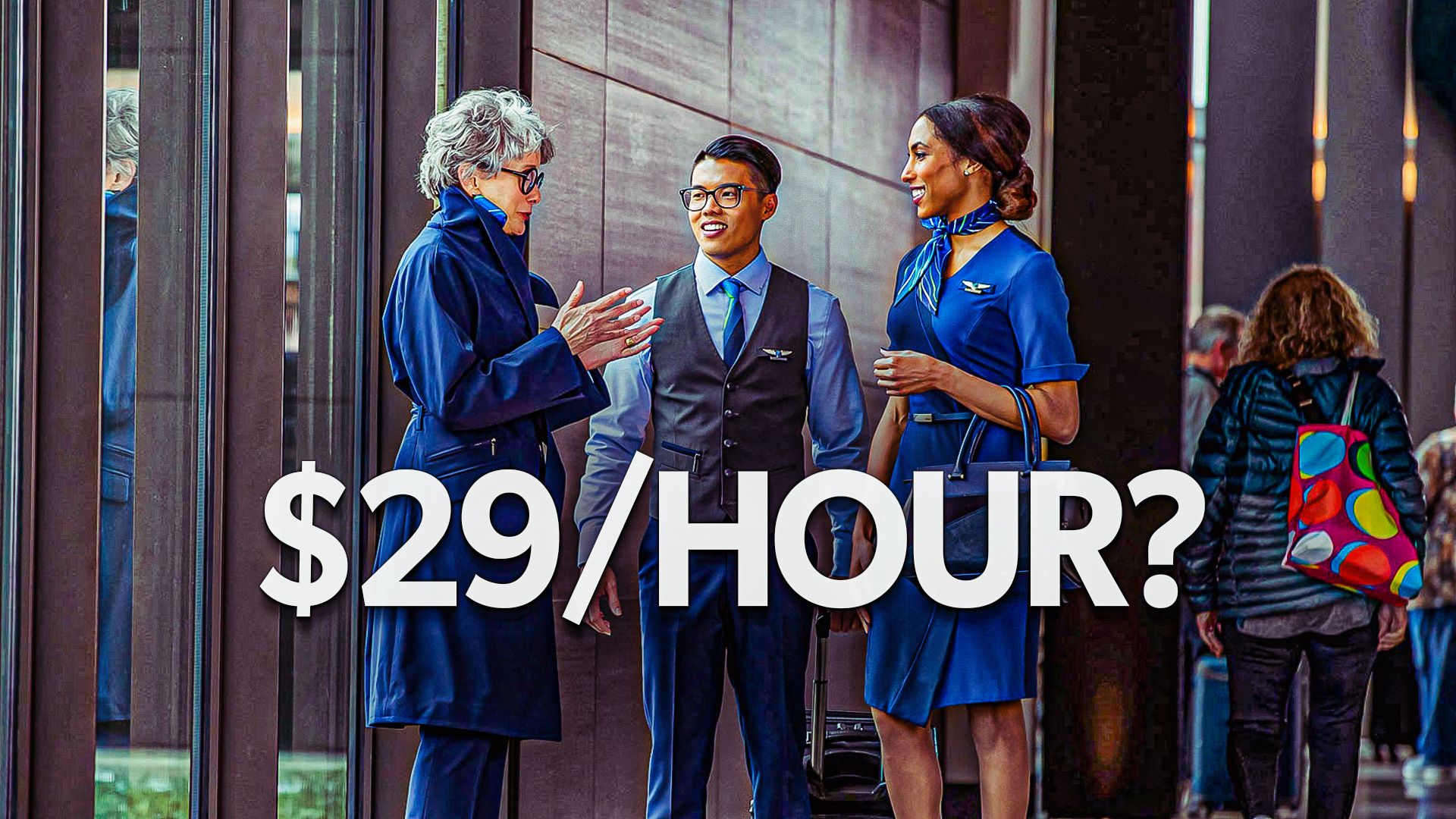Business
Flight Attendant Salaries Surge in 2025 Amid Rising Costs

In 2025, flight attendant salaries in the United States are experiencing significant shifts, driven by rising living costs, new union negotiations, and heightened public interest in compensation transparency. As the demand for skilled cabin crew increases, understanding salary structures has become essential for those considering a career in the skies. The reality is that flight attendant pay is complex and influenced by various factors, including flight hours, airline contracts, per diem allowances, and whether time spent on the ground is compensated.
Base Pay and Earnings Overview
Flight attendants operate under detailed collective bargaining agreements that dictate their compensation and benefits. These contracts, often negotiated by unions, outline provisions such as step increases, duty pay, per diem, bonuses, and allowances. For example, at United Airlines, new attendants start at USD 28.88 per flight hour, with pay rising to USD 67.11 after 13 years of service. A proposed update aims to increase starting pay to USD 36.92 per hour and senior pay to USD 96.58 per hour, marking the inclusion of boarding pay for the first time.
Regional carriers, historically on the lower end of the pay scale, are catching up. Endeavor Air, a subsidiary of Delta Connection, starts its flight attendants at USD 25.84 per hour, increasing to USD 29.70 after two years. These airlines supplement base wages with daily per diem payments, crucial for crew members spending nights away from home. Recent years have seen incremental wage increases and enhanced duty protections, making regional flying more competitive.
Modern contracts are beginning to reflect evolving workplace expectations. Compensation is now offered for reserve duty, ground delays, and leadership roles, alongside incentives for holiday or international flights. As one recent agreement indicates, reserve attendants at United now earn an additional USD 2 per hour, while lead positions such as purser receive premium pay. This trend highlights the industry’s movement towards acknowledging all aspects of a flight attendant’s workday.
Personal Insights from Flight Attendants
Behind the statistics, flight attendants share personal stories that highlight the balance of passion and practicality in their careers. On platforms like Reddit, crew members discuss their real-life experiences with pay structures. One United flight attendant noted, “You get one hour of pay per flight hour, or half an hour per hour away from base, whichever adds up to more. Usually, the flight hours win out.” Others mention the challenges posed by long ground delays: “You’ll get ground pay for a maximum of 30 minutes on a four-hour sit. The first two and a half hours aren’t paid.”
Many new hires struggle financially, often living with roommates or taking on extra shifts. However, with seniority and consistent long-haul flying, some reach annual earnings exceeding six figures. Those who manage to navigate packed schedules or back-to-back trips typically see their income grow the fastest. Despite modest beginnings, many flight attendants describe their job as deeply rewarding, with travel perks, global friendships, and flexible schedules often mitigating early pay challenges.
The strong sense of community within airline crews further enhances job satisfaction. Surveys conducted by the Association of Flight Attendants reveal that over 80% of respondents would choose this career again, despite its demanding nature.
Leading Airlines in Compensation
While compensation varies significantly among airlines, 2025 has seen new leaders emerge. According to Bandana Resources, Delta Air Lines flight attendants rank among the highest earners, with top salaries reaching USD 107,000 annually, approximately USD 83 per hour. American Airlines follows closely, with annual earnings of USD 109,000, including boarding pay. United Airlines offers a cap near USD 80,500, or about USD 67 per hour, after 12 years. JetBlue Airways also provides competitive hourly rates at USD 67.87.
Recent union agreements have contributed to these rising figures. In early 2025, flight attendants at Alaska Airlines ratified a contract that includes 18-28% raises, two years of back pay, and provisions for boarding pay. Other major US carriers are seeking similar improvements in response to increasing pressure from crew unions and public scrutiny regarding unpaid duty time.
As noted by The Guardian, airlines across North America and Europe are under growing scrutiny for unpaid ground time, with many beginning to recognize that time spent boarding, waiting, or deplaning constitutes part of the workday. These reforms signal that future contracts could close the longstanding disparity between scheduled hours and paid hours.
Understanding the Variability in Salaries
Several key factors influence the earnings of flight attendants, even among those operating similar routes. The type of flights is a major determinant; long-haul international trips often come with night differentials, foreign allowances, and layover pay, whereas domestic schedules typically offer flatter structures. Crew members on overseas routes can potentially enhance their annual income with these additional components.
Ground compensation policies also play a critical role. Some airlines compensate for time spent boarding and during delays, while others limit pay to the hours between takeoff and landing. As the industry evolves, more attendants are advocating for full pay for all duty hours, reflecting a broader sentiment that “if we’re at work, we should be paid.”
Moreover, the cost of living and base location add layers of complexity to salary discussions. Flight attendants based in major cities or international hubs often receive higher allowances to offset living expenses, while those in smaller hubs may benefit from lower housing costs but have fewer premium flights. When combined with seniority systems and company profitability, it’s clear why total earnings can vary significantly, even within the same airline.
Looking Ahead: The Future of Flight Attendant Compensation
The pay structure for flight attendants is evolving rapidly in 2025, driven by rising living costs, union activism, and increased awareness of unpaid ground time. Upcoming labor agreements at United, American, and Delta are expected to establish new industry standards. While entry-level pay remains modest, the upward trend is evident as airlines compete for qualified cabin crew, recognizing that fair compensation is vital for staff retention.
Despite these changes, many flight attendants find the allure of their profession extends beyond financial rewards. The flexibility, opportunities for global travel, and camaraderie among crew members continue to be significant motivators. If current reform trends persist, 2025 could herald a transformative era for cabin crew, ensuring they receive fair compensation for all aspects of their work, both in the air and on the ground.
-

 Entertainment1 month ago
Entertainment1 month agoAnn Ming Reflects on ITV’s ‘I Fought the Law’ Drama
-

 Entertainment2 months ago
Entertainment2 months agoKate Garraway Sells £2 Million Home Amid Financial Struggles
-

 Health1 month ago
Health1 month agoKatie Price Faces New Health Concerns After Cancer Symptoms Resurface
-

 Entertainment1 month ago
Entertainment1 month agoWhere is Tinder Swindler Simon Leviev? Latest Updates Revealed
-

 Entertainment2 months ago
Entertainment2 months agoKim Cattrall Posts Cryptic Message After HBO’s Sequel Cancellation
-

 Entertainment1 month ago
Entertainment1 month agoCoronation Street’s Carl Webster Faces Trouble with New Affairs
-

 Entertainment2 months ago
Entertainment2 months agoMasterChef Faces Turmoil as Tom Kerridge Withdraws from Hosting Role
-

 Entertainment3 months ago
Entertainment3 months agoSpeculation Surrounds Home and Away as Cast Departures Mount
-

 World1 month ago
World1 month agoCole Palmer’s Mysterious Message to Kobbie Mainoo Sparks Speculation
-

 Entertainment1 month ago
Entertainment1 month agoITV’s I Fought the Law: Unraveling the True Story Behind the Drama
-

 Entertainment4 weeks ago
Entertainment4 weeks agoCaz Crowned Winner of The Great British Sewing Bee, Overjoyed by Triumph
-

 Entertainment2 months ago
Entertainment2 months agoAldi Launches Cozy Autumn Fragrance Range Ahead of Halloween



















